The Dell Venue 11 Pro 7000 Review
by Brett Howse on April 16, 2015 8:00 AM EST- Posted in
- Tablets
- Dell
- Windows 8.1
- Core M
Tablet Performance
So far we have compared the Venue 11 Pro with its Windows PC based brethren. And that is a fair comparison to make, since the Venue 11 Pro is offered with accessories to transform it into exactly that. But to complete the picture we should take a look at how it performs as a pure tablet.
We do not have all of the same benchmarks available on Windows as we do on iOS and Android, but we will make what comparisons we can to get a general feel for how this tablet compares against competing devices.
Web Performance
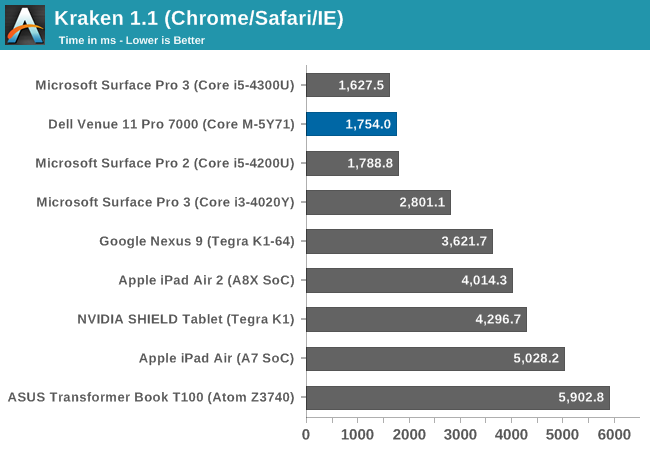
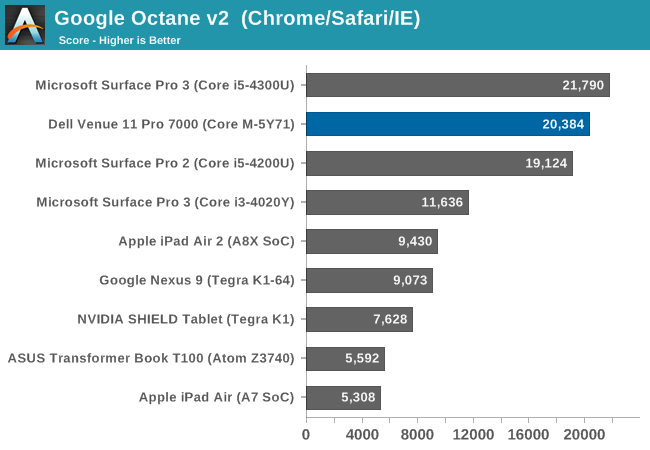

Core M offers a lot more performance than any of the ARM based tablets when it comes to CPU bound tasks. It is easily double the performance of the best ARM or Atom based devices. It is a pretty great achievement when you look at how far back Intel was in the mobile game a few years ago. Atom got them to somewhat competitive performance and TDP, but Core M has pushed them well past. Of course that is ignoring the huge price differential, with the Core M CPU having a tray price of more than many Android tablets, as well as the larger circuit board that Core M requires. Intel still has Atom, and for good reason. They can and do price Core M at a premium, but have Atom to provide the less expensive option.
3DMark Unlimited
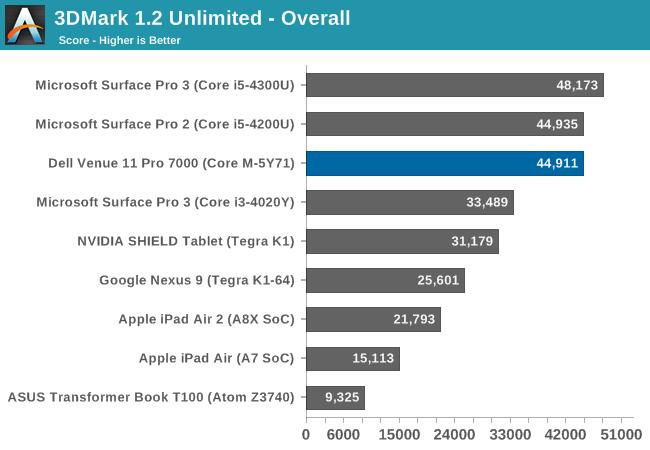
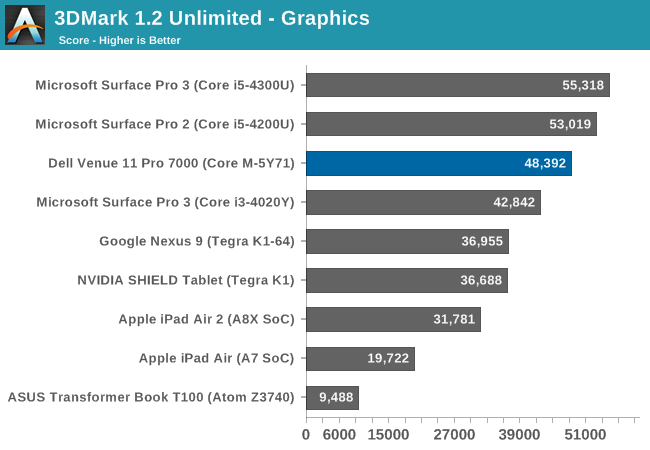
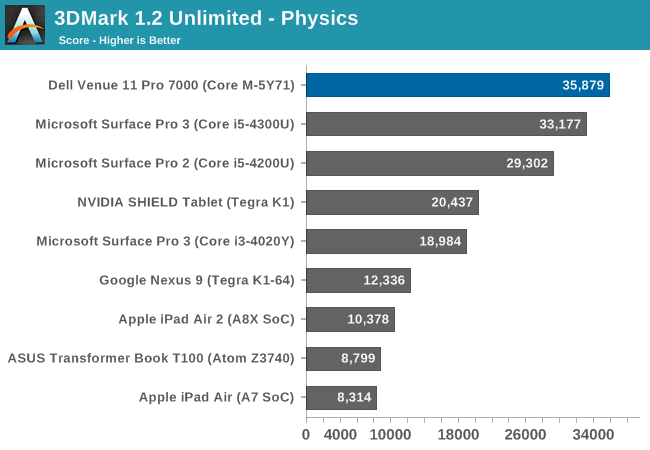
Ice Storm Unlimited is rendered off-screen, so that it can be used to compare across devices and platforms. As we have seen in the PC comparison, the Venue 11 Pro can perform quite well if given such a short benchmark. This does show to capabilities of the GPU inside, but unfortunately it is more limited in performance when doing longer workloads.
GFXBench
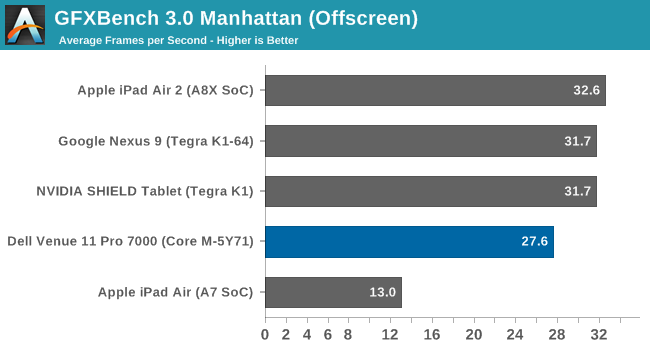
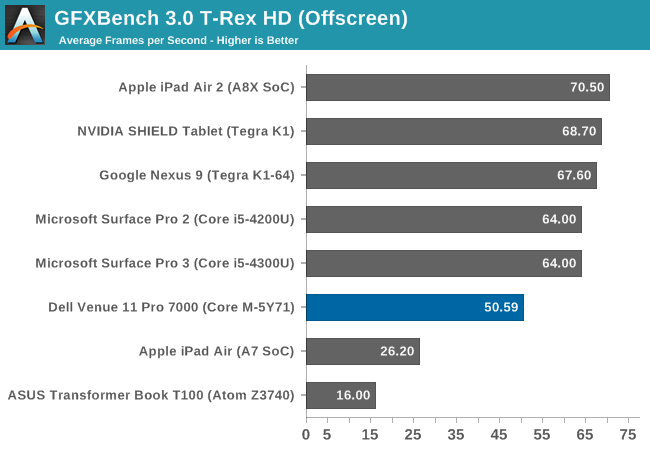
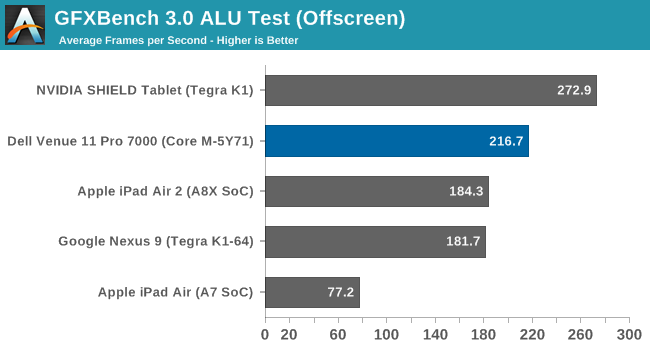
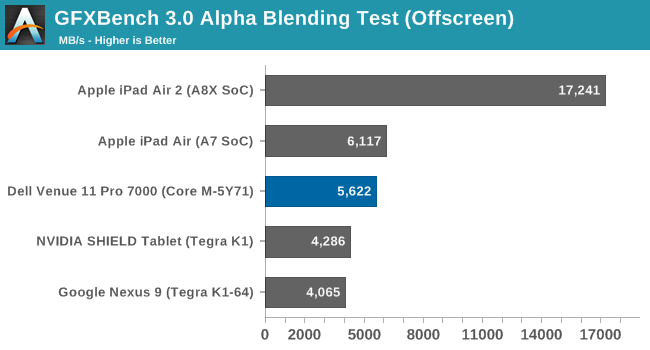
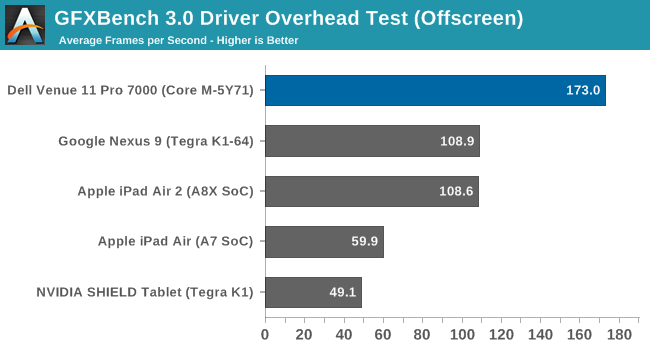
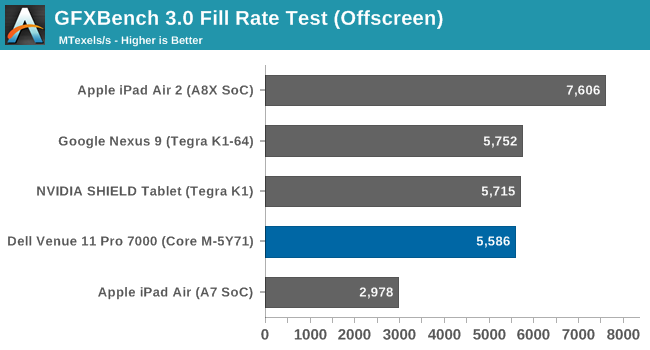
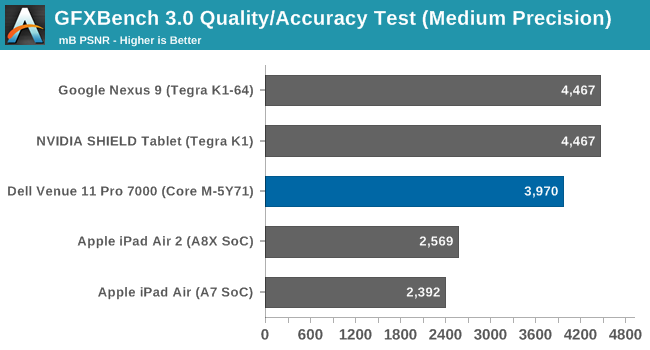
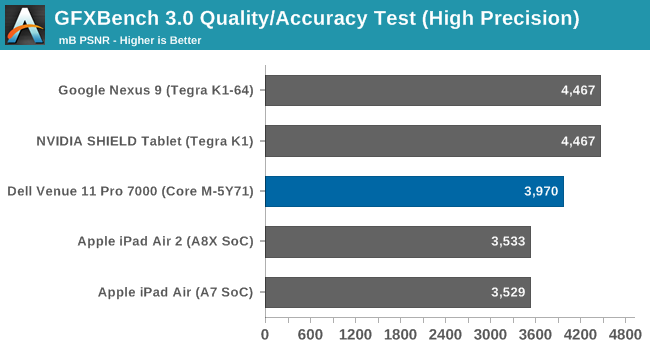
On the CPU side, Core M dominates the ARM competition, but on the GPU front it is not the same story. As we saw in 3DMark, the GPU can perform very well, but on a test like this where sustained performance is required, the performance does drop off quite a bit. The GPU is not terrible, but it cannot compete with the top GPUs available in a tablet today. Perhaps that will change with Skylake. At the moment, it is only ok.
NAND Performance
The Venue 11 Pro has an older model of SSD, but it is still a SSD, where as most tablets are outfitted with some form of eMMC storage.

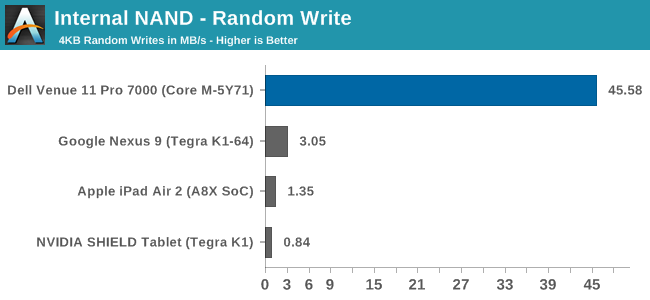
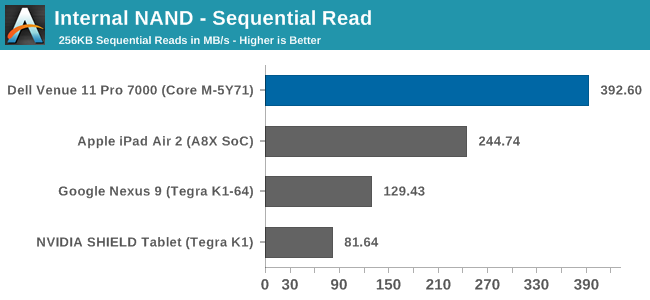
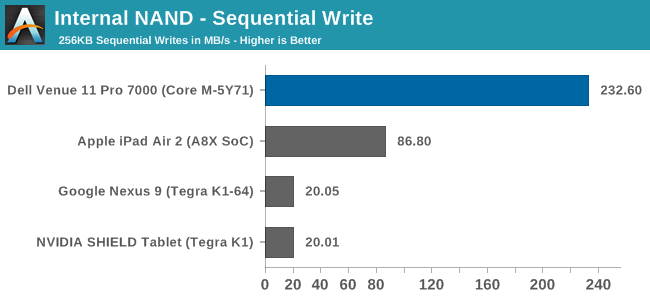
Building a tablet out of PC components still has its upsides, and storage performance is one of them. There is still quite a gap between a true SSD and eMMC storage. The Venue 11 Pro has the SanDisk X110 SSD, which is an older model drive, yet performance is still a good bit better than the average tablet.
Tablet Performance Summary
The Venue 11 Pro, with Windows 8.1, a Core M CPU, and a SSD, has very competetive performance compared to the standard tablets of today. There are certainly advantages to a true tablet, such as weight and thickness, but as far as performance, the Venue 11 Pro outclasses these devices in everything except GPU performance. The GPU performance is still good, but it is not class leading.










92 Comments
View All Comments
duriel - Thursday, April 16, 2015 - link
The GPU comparison looks a bit strange, since Core M does quite a bit better at 3DMark than at GfxBench. Both Manhattan and IceStorm run for a couple of minutes, so I don't buy the argument that GfxBench is slower because it runs longer (although that might be true for actual games like Dota). Perhaps it is a driver / application optimization issue. I wonder if GfxBench uses OpenGL or DirectX on Windows. Intel is generally known to have better DX drivers than OGL. Too bad we don't have more cross platform graphics benchmarks.lilmoe - Thursday, April 16, 2015 - link
I've seen other reviews around too, and I don't base my judgements on benchmarks alone. It really seams that the GPU is not up to task. How much could they mess up the driver? This isn't Intel's first attempt at iGPUs...thunng8 - Friday, April 17, 2015 - link
Ice Storm is a fair bit shorter than gfxBench benchmarks and IMO gfxBench graphically looks much better especially ManhattanShadowmaster625 - Thursday, April 16, 2015 - link
I hope they keep pushing these thigns out. When we go into the next recession these things will be all over slickdeals for $400 maybe even $300. At around $400 this is a very compelling product.chizow - Thursday, April 16, 2015 - link
I was part of the validation process for these Venue Pros and other tablet/2-in-1s for work and we decided not to use these in favor of the Surface Pro 3 mixed in with some Yoga Pros and Transformer T300s (for users who wanted more of a 2-in-1 experience).There were a number of major problems with the Venue Pro that we ran into compared to the competitors and really only one positive.
Pros: Take care of this easy one first, it has a built-in SC Reader. It works poorly, but it is there. This is an important feature for any Enterprise that does business with the Government or has the highest security standards.
Cons:
-1080p 16:9 aspect ratio is terrible for tablet portrait usage. Works OK on a smartphone because that's all we've ever known, but for web content and even most documents, 16:9 just doesn't work and often forces you to scroll LR on a page, especially if there is a menu/banner on either side.
-Heavy and thick. Just feels really heavy. Maybe its due to the stocky dimensions, but it just feels heavy in the hand and it is considerably thicker than the SP3. It feels even worst as a tablet than the original Surface Pro and Pro 2.
-Dock. Price and overall build quality on the dock is good, but attaching it is not as easy as the SP3 dock and you also can't attach the keyboard while docked like you can with the SP3's dock. Also not as many connectivity options but overall the dock is good especially for the price.
-Folio Keyboard. This thing is awful, can't even be compared to the SP3's dock and it is also unnecessarily thick due to the multiple manifolds required for its stand-up folio action. The keyboard itself feels awful, almost no key travel it is more like the touchpads that also double as buttons for your entire keyboard. Also, in "laptop" mode it just doesn't work well because the tablet is SO much heavier than the keyboard and the only support you have is the flexible folio back kickstand. If you want a 2-in-1 spring for the new rigid typepad/battery accessory or look at the Asus Transformer T300 or Yoga Pro 3.
-Probably no longer an issue with this Core M variant, but the i5 unit I had the fan would ramp up and it would get LOUD.
So yeah, would definitely check this one out in person before you buy, from my testing and time spent validating multiple of these options, I would spend a bit more and go with a Surface Pro 3 i5 variant with 4GB/128GB or 8GB/256GB or one of the higher-end Surface 3 (non-Pro). Surface Pro line is probably due for an update soon anyways, I would expect to see a Core M variant replacing the low-end i3.
Brett Howse - Thursday, April 16, 2015 - link
So just to clarify, your experience is with the older model then? Obviously this one is quiet since it is passively cooled. It's great to hear from people who have a lot of experience with these devices.chizow - Friday, April 17, 2015 - link
Yeah it was the older i5 model but I figured Core M would quiet it down which is great to hear. I did also go back and read the parts of the review on the dimensions and it does look like they addressed the thickness and weight concerns somewhat, but I am not sure they've done enough to address the 2-in-1 and screen size/aspect ratio concerns.In any case I do laud Dell for taking a chance on this segment but like the Surface Pro line, I think more iterations and improvements are needed for this product to do well.
DigitalFreak - Thursday, April 16, 2015 - link
We bought a bunch of these @ work. Absolute junk. Do yourself a favor and look at the Lenovo Helix.lilmoe - Thursday, April 16, 2015 - link
Mind sharing your experience? Was it performance or overall quality?Azurael - Thursday, April 16, 2015 - link
Was that the previous 7130 model? They launched with a shedload of issues after receiving numerous positive reviews. The screen would freeze frequently unless panel self refresh was disabled, the touch screens would register double taps constantly, the stylus was basically useless and the SSDs got laggy over time. After several BIOS updates and firmware updates for almost every component I could imagine having updateable firmware (and not just the touch controller, but the LCD panel itself) it works great. I think Dell really dropped the ball, I assume businesses had already given up on them by that point which is good for me, because refurbs are numerous and cheap :)